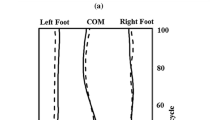Abstract
This study compares the gait of chronic ambulatory hemiplegic elderly (HE) with those of non-hemiplegic elderly (NHE) using Vicon® 512 motion analysis system to track movement trajectories. Subjects walked with self-selected gait speeds while temporal, spatial, and kinematic variables were analyzed. HE showed significantly decreased walking speed, cadence, stride length, and step length, and increased stride time, step time, and double limb support periods in comparison with NHE. Double limb support of stance phase was significantly increased in HE. In HE, affected pelvis showed marked upward elevation from terminal stance to mid swing phase, and greater external rotation than the NHE (p<0.05). Affected hip showed increased external rotation than the NHE. Affected knee showed loss of first and second flexion waves in sagittal plane. Affected ankle also showed reduced first rocker, and outward foot progression angle compared to NHE. Our results suggest that the major coping mechanism of HE to maintain balance and to continue walking is to increase the stance time of affected limb inevitably sacrificing walking speed. This study points to the importance and necessity of building a rehabilitation program that decrease the double limb support of affected limb while maintaining gait speed in the HE.
Similar content being viewed by others
Abbreviations
- HE:
-
chronic ambulatory hemiplegic elderly
- NHE:
-
non-hemiplegic elderly
- IDLS:
-
Initial double limb support
- ALSS:
-
Affected limb single support
- TDLS:
-
Terminal double limb support
- SLSS:
-
Sound limb single support
- AFO:
-
Ankle Foot Orthosis
References
Liu, M. Q., Anderson, F. C., Pandy, M. G., and Delp, S. L., “Muscles that Support the Body also Modulate Forward Progression during Walking,” Journal of Biomechanics, Vol. 39, No. 14, pp. 2623–2630, 2006.
Murray, M. P., Kory, R. C., and Clarkson, B. H., “Walking Patterns in Healthy Old Men,” Journal of Gerontology, Vol. 24, No. 2, pp. 169–178, 1969.
Öberg, T., Karsznia, A., and Öberg, K., “Basic Gait Parameters: Reference Data for Normal Subjects, 10-79 Years of Age,” Journal of Rehabilitation Research and Development, Vol. 30, No. 2, pp. 210–223, 1993.
Pang, M. Y., Eng, J. J., Dawson, A. S., McKay, H. A., and Harris, J. E., “A Communitybased Fitness and Mobility Exercise Program for Older Adults with Chronic Stroke: A Randomized, Controlled Trial,” Journal of the American Geriatrics Society, Vol. 53, No. 10, pp. 1667–1674, 2005.
Kwolek, A. and Zuber, A., Gait Characteristics in Hemiparetic Patients after Stroke,” Neurologia I Neurochirurgia Polska, Vol. 36, No. 2, pp. 337–347, 2002.
Harris-Love, M. L., Forrester, L. W., Macko, R. F., Silver, K. H., and Smith, G. V., “Hemiparetic Gait Parameters in Overground Versus Treadmill Walking,” Neurorehabilitation and Neural Repair, Vol. 15, No. 2, pp. 105–112, 2001.
Chen, C. L., Chen, H. C., Tang, S. F. T., Wu, C. Y., Cheng, P. T., and Hong, W. H., “Gait Performance with Compensatory Adaptations in Stroke Patients with Different Degrees of Motor Recovery,” American Journal of Physical Medicine & Rehabilitation, Vol. 82, No. 12, pp. 925–935, 2003.
Chen, G., Patten, C., Kothari, D. H., and Zajac, F. E., “Gait Differences between Individuals with Post-Stroke Hemiparesis and Non-Disabled Controls at Matched Speeds,” Gait & Posture, Vol. 22, No. 1, pp. 51–56, 2005.
Balasubramanian, C. K., Neptune, R. R., and Kautz, S. A., “Variability in Spatiotemporal Step Characteristics and Its Relationship to Walking Performance Post-Stroke,” Gait & Posture, Vol. 29, No. 3, pp. 408–414, 2009.
Perry, J., “The Mechanics of Walking in Hemiplegia,” Clinical Orthopaedics and Related Research, Vol. 63, pp. 23–31, 1969.
Brandstater, M., De Bruin, H., Gowland, C., and Clark, B., “Hemiplegic Gait: Analysis of Temporal Variables,” Archives of Physical Medicine and Rehabilitation, Vol. 64, No. 12, pp. 583–587, 1983.
Goldie, P. A., Matyas, T. A., and Evans, O. M., “Gait after STROKE: Initial Deficit and Changes in Temporal Patterns for each Gait Phase,” Archives of Physical Medicine and Rehabilitation, Vol. 82, No. 8, pp. 1057–1065, 2001.
Dettmann, M. A., Linder, M. T., and Sepic, S. B., “Relationships Among Walking Performance, Postural Stability, and Functional Assessments of the Hemiplegic Patient,” American Journal of Physical Medicine & Rehabilitation, Vol. 66, No. 2, pp. 77–90, 1987.
Wall, J. C. and Turnbull, G. I., “Gait Asymmetries in Residual Hemiplegia,” Archives of Physical Medicine and Rehabilitation, Vol. 67, No. 8, pp. 550–553, 1986.
Chen, G., Patten, C., Kothari, D. H., and Zajac, F. E., “Gait Deviations Associated with Post-Stroke Hemiparesis: Improvement during Treadmill Walking using Weight Support, Speed, Support Stiffness, and Handrail Hold,” Gait & Posture, Vol. 22, No. 1, pp. 57–62, 2005.
Author information
Authors and Affiliations
Corresponding author
Rights and permissions
About this article
Cite this article
Kim, J., Oh, SI., Cho, H. et al. Gait patterns of chronic ambulatory hemiplegic elderly compared with normal Age-Matched elderly. Int. J. Precis. Eng. Manuf. 16, 385–392 (2015). https://doi.org/10.1007/s12541-015-0051-z
Received:
Revised:
Accepted:
Published:
Issue Date:
DOI: https://doi.org/10.1007/s12541-015-0051-z




